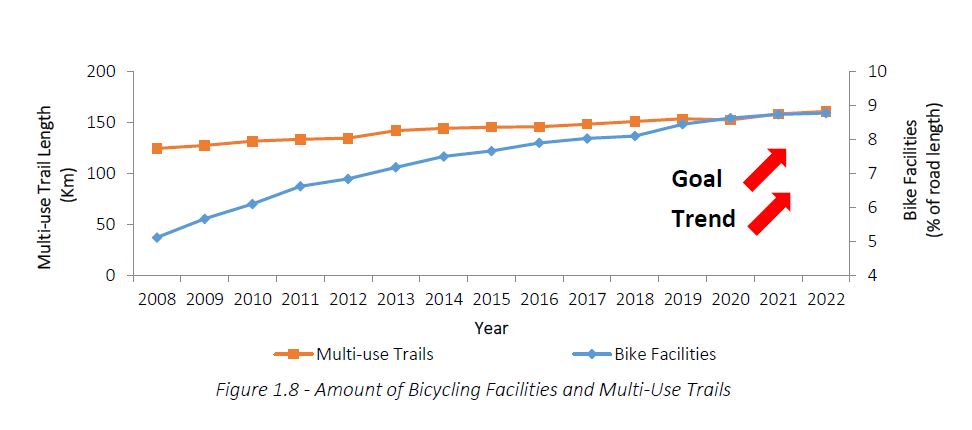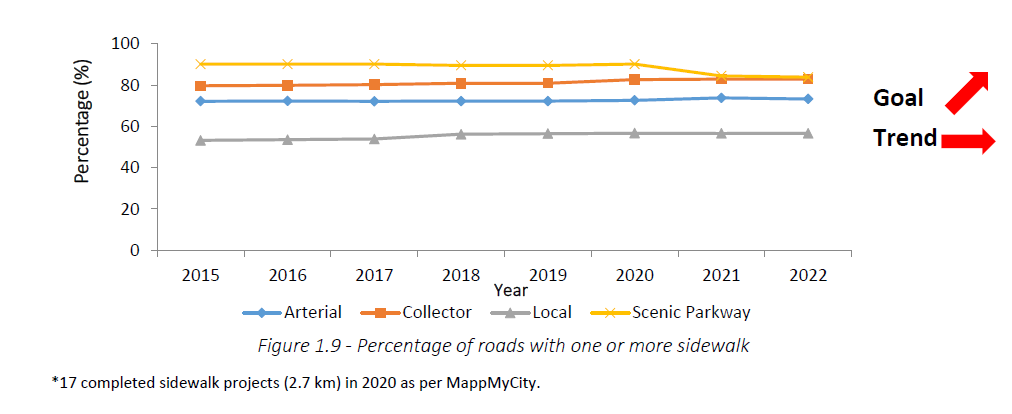Connect Network of Safe Bicycling and Walking Facilities
Objective A9: Develop, Expand and Maintain a Connected Network of Safe Bicycling and Walking Facilities
The following actions are needed to complete this objective:
- Develop and implement an active transportation master plan, including cycling, walking and public transit, and associated policies, procedures, standards and best practices.
- Develop a Complete Streets Policy.
- Continue to provide long-term committed funding to expand Windsor’s existing commuter and recreational cycling and walking networks.
- Include cycling and walking facilities in road reconstruction projects and incorporate active transportation needs into street design.
- Establish bike friendly design requirements for municipal roads and at municipal buildings, public spaces, parks and transit stops.
- Establish bike-friendly design requirements and bike parking policy for public, private and institutional facilities.
- Improve the cycling-transit and walking-transit links.
- Promote bicycling and walking as a healthy alternative for residents and staff.
- Promote injury prevention messaging and education, such as bike safety, wearing helmets, rules of the road for cyclists, etc.
- Ensure new developments include sidewalks and target existing neighbourhoods without sidewalks for expansion of walking facilities.
These indicators show the progress the City is making to achieve this objective:
- Length of cycling network
- Percentage of roads with one or more sidewalks
Trails Indicator

Trails promote walking and cycling as alternative means of getting from one place to another. There are several categories of trails: on-road bicycle lanes, off-road bicycle paths, multi-use trails, and walking trails.
An extensive cycling network that connects neighbourhoods throughout the city is necessary to making Windsor a more environmentally friendly community.
The total length of trails is one indicator of how available and useful the trail network is to residents of Windsor. In general, more trails means more options for people to make trips without an automobile. An extensive network of trails also creates options for recreation and physical fitness.
How are we doing?

As seen in the graph above, the amount of bicycling facilities and multi-use trails have both increased since 2008.
A Multi-use Trail is any off-road paved pathway that is designated for pedestrians and in-line skaters as well as non-motorized vehicles such as cyclists. Such trails are physically separated from the road.
Bike Facilities include sharrows (road markings indicating that cyclists and motorists share the lane), signed bicycle routes and bicycle lanes.
Learn more about Windsor's Trails.

As illustrated in the graph above, the percentage of roads with one or more sidewalks has not significantly increased since 2015.
What is the City of Windsor doing to increase the number of trails?
- The City of Windsor has been actively developing a cycling and multi-use recreation network since 1991 with the adoption of the Bicycle Use Development Study (BUDS). The completion of a comprehensive cycling network is viewed as integral to Windsor's vision for a balanced transportation system.
- In 2001, City Council adopted the Bicycle Use Master Plan (BUMP). Since the adoption of the BUMP, the City has been filling in the gaps in the existing recreation way network and improving connections to, from and between existing cycling facilities.
- The City has partnered with the Waterfront Regeneration Trust to extend the Waterfront Trail through the City of Windsor, connecting to the Town of Tecumseh to the east and the Town of LaSalle to the west, adding an additional 620 kilometres to the trail.
- Seventeen kilometres of multi-use trail will be incorporated into the Right Honourable Herb Gray Parkway. This trail ties in with existing neighbourhood trails to promote active transportation.
- The City supports the principle of consolidating rail traffic onto a few key rail lines so that some lines can be abandoned and converted to other uses. A network of trails, parks and green space could be constructed along certain existing rail corridors once they are no longer needed for trains. In 2008, a strategic planning study was completed by the City of Windsor and Transport Canada to assess the opportunities for rail rationalization. Such rationalization would require major investments by the federal government and the rail companies. More information can be found on the Transportation Studies, EAs and Reports page.
- The overarching target listed in the Active Transportation Master Plan is to double the amount of trips made by walking, cycling and transit by 2031, with a longer-term target of 25% of all trips in Windsor made using sustainable transportation by 2041.
What can you do to promote the creation and use of trails?

Participate in the Active Transportation Expert Panel, which advises Council and City departments on matters relating to bicycling in Windsor.
Keep up to date on environmental assessments being conducted in Windsor and attend public open house events, where you can provide comments regarding the inclusion of bicycle lanes as part of road reconstruction projects.
For a list of current studies that are underway and how to get involved, see the second half of the Environmental Assessments & Master Plans Page.
Make active use of the trails that exist throughout Windsor. Advocate for added green space during the next Official Plan Review. In addition to their environmental benefits, parks and trails often contribute to higher real estate value, because residential properties adjacent to these areas are generally more desirable.
The Strategic Rail Study, completed in 2008, identified the potential for certain rail corridors to be converted into other uses, including trails. One example of railway tracks that have been converted to recreational trails is the Hamilton to Brantford Rail Trail in Ontario. Interested residents can contact the Federal Government to express their support for rail rationalization.
For more information on environmental initiatives:
Phone: For general information, call 311. For detailed inquiries, call 519-255-6100 ext. 6127.
E-mail: emp@citywindsor.ca
